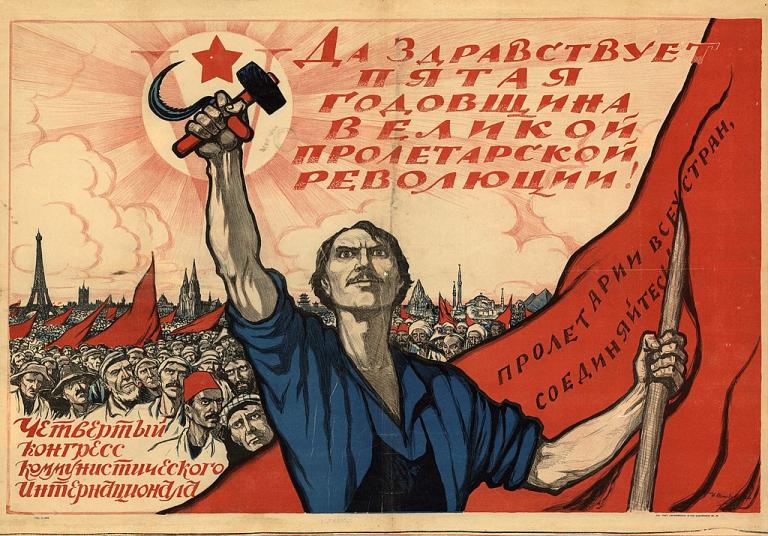Marxists, as you will recall, believe that history is the story of conflict between socio-economic classes, and that one day the working class will rise up in revolution to overthrow the middle class property owners, ushering in the “workers’ paradise” of communism.
Most of today’s Leftists are “post-Marxists,” substituting out other kinds of group oppressions–races, sexes, sexual preferences, species, etc.–for the old class struggle. But you can still find classic Marxists pining for a communist revolution.
What surprised me, though, is at least some of them are forming an alliance with the New Right. What surprised me even more is that some on the Trump-supporting New Right are open to forming an alliance with them!
I came across a fascinating article by New York University sociologist Vivek Chibber entitled How Capitalism Endures, This article is adapted from his book The Class Matrix: Social Theory after the Cultural Turn, which, judging from the Amazon descriptions, is a Marxist critique of the new left’s attention to culture rather than to economic class. He argues that cultural issues too have a “materialist” basis, and he attempts to bring Gramsci (a father of “cultural” Marxism) and Marx back together.
Chibber points out that today’s left is mostly bourgeois, with little connection to the proletariat.
Today, insofar as there is a left in the core economies of the advanced industrial world, it is largely divorced from the working class. It is housed mainly in professional settings like university campuses and nonprofit organizations, not in the neighborhoods and productive establishments where labor confronts capital.
Meanwhile, working class discontent is expressing itself in populist politics (my emphasis):
To the extent that members of the working class have expressed their discontent, they have done so with the means available to them, and the only such means universally available at present is the ballot box. No wonder, then, that the discontent has tended to be electoral in form and that the explosion has been populist in content, whether on the left or right. The new populist wave of the past decade is the new face of working-class rebellion today.
That is to say, Donald Trump and his supporters are the vanguard of the proletariat revolution!
The article was published in the online magazine Compact, a flagship forum for the New Right. According to its Wikipedia article, the publication was founded by Sohrab Ahmari, of “Against David French-ism” fame; Matthew Schmitz, the former senior editor of First Things; and Edwin Aponte, described as a “Marxist populist.” Wikipedia reports that Aponte came on board after he was assured “that half of the site’s content cover ‘material concerns,'” which is Marxist jargon for historical materialism, with its implications of economic determinism and class struggle.
I can’t understand how the two Catholics, Ahmari and Schmitz, could agree to this. As integralists (Adrian Vermeule is a contributing editor), they oppose “liberalism,” including what they call “liberal conservatism”–that is, the emphasis on liberty. They have that in common with communists.
See also Stephanie Slade’s article in the libertarian magazine Reason entitled In a New Magazine, the Illiberal Right and the Illiberal Left Converge with the deck “Compact brings ‘labor populism’ and ‘political Catholicism’ under one roof.” She writes,
Americans are primed to think of their politics in terms of a left-right spectrum. But these days, the more interesting and important divide is the liberalism schism, with liberal in this context referring to the principles of classical liberalism rather than left-of-center politics. Both left liberals and right liberals generally support due process, free trade, religious liberty, and the like, although left liberals are usually less concerned with economic freedom than are right liberals. . . .
Compact appears as a high-profile effort to introduce a united illiberal front, one that couples support for state enforcement of traditional social mores with a healthy appetite for redistribution and central planning of the economy. (For what it’s worth, the first day’s offerings point as well to a strong anti-interventionist bent on foreign policy.) Gluing it all together is the editors’ certainty that liberalism, whether on the left or on the right, is the enemy. . . .
By bringing a “labor populism” with deep roots in the socialist tradition and a “political Catholicism” that questions the very separation of church and state under a single roof, Compact has built an intellectual meeting place not just for post-liberal conservatives but for anti-liberals of every stripe. Watch out.
As a survivor of the Cold War and as an old-school anti-communist, anti-totalitarian, small government conservative, I second that emotion: “Watch out.”
Illustration: Soviet poster dedicated to the 5th anniversary of the October Revolution and IV Congress of the Communist International (1922). Иван Васильевич Симаков / Ivan Vasilyevich Simakov ( 1877—1925) [1], Public domain, via Wikimedia Commons



















